Specific roles of AMPA receptor subunit GluR1 (GluA1) phosphorylation sites in regulating synaptic plasticity in the CA1 region of hippocampus
- PMID: 19906877
- PMCID: PMC2807233
- DOI: 10.1152/jn.00835.2009
Specific roles of AMPA receptor subunit GluR1 (GluA1) phosphorylation sites in regulating synaptic plasticity in the CA1 region of hippocampus
Abstract
Activity-dependent changes in excitatory synaptic transmission in the CNS have been shown to depend on the regulation of alpha-amino-3-hydroxy-5-methyl-4-isoxazole propionic acid receptors (AMPARs). In particular, several lines of evidence suggest that reversible phosphorylation of AMPAR subunit glutamate receptor 1 (GluR1, also referred to as GluA1 or GluR-A) plays a role in long-term potentiation (LTP) and long-term depression (LTD). We previously reported that regulation of serines (S) 831 and 845 on the GluR1 subunit may play a critical role in bidirectional synaptic plasticity in the Schaffer collateral inputs to CA1. Specifically, gene knockin mice lacking both S831 and S845 phosphorylation sites ("double phosphomutants"), where both serine residues were replaced by alanines (A), showed a faster decaying LTP and a deficit in LTD. To determine which of the two phosphorylation sites was responsible for the phenotype, we have now generated two lines of gene knockin mice: one that specifically lacks S831 (S831A mutants) and another that lacks only S845 (S845A mutants). We found that S831A mutants display normal LTP and LTD, whereas S845A mutants show a specific deficit in LTD. Taken together with our previous results from the "double phosphomutants," our data suggest that either S831 or S845 alone may support LTP, whereas the S845 site is critical for LTD expression.
Figures
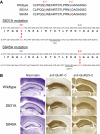
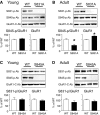

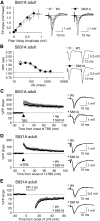

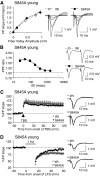
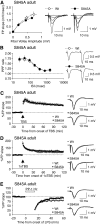

Similar articles
-
AMPA receptor subunit GluR1 (GluA1) serine-845 site is involved in synaptic depression but not in spine shrinkage associated with chemical long-term depression.J Neurophysiol. 2011 Apr;105(4):1897-907. doi: 10.1152/jn.00913.2010. Epub 2011 Feb 9. J Neurophysiol. 2011. PMID: 21307330 Free PMC article.
-
AKAP150-anchored calcineurin regulates synaptic plasticity by limiting synaptic incorporation of Ca2+-permeable AMPA receptors.J Neurosci. 2012 Oct 24;32(43):15036-52. doi: 10.1523/JNEUROSCI.3326-12.2012. J Neurosci. 2012. PMID: 23100425 Free PMC article.
-
Control of Homeostatic Synaptic Plasticity by AKAP-Anchored Kinase and Phosphatase Regulation of Ca2+-Permeable AMPA Receptors.J Neurosci. 2018 Mar 14;38(11):2863-2876. doi: 10.1523/JNEUROSCI.2362-17.2018. Epub 2018 Feb 13. J Neurosci. 2018. PMID: 29440558 Free PMC article.
-
How Ca2+-permeable AMPA receptors, the kinase PKA, and the phosphatase PP2B are intertwined in synaptic LTP and LTD.Sci Signal. 2016 Apr 26;9(425):e2. doi: 10.1126/scisignal.aaf7067. Sci Signal. 2016. PMID: 27117250 Review.
-
AMPA receptor regulation during synaptic plasticity in hippocampus and neocortex.Semin Cell Dev Biol. 2011 Jul;22(5):514-20. doi: 10.1016/j.semcdb.2011.06.007. Epub 2011 Aug 12. Semin Cell Dev Biol. 2011. PMID: 21856433 Free PMC article. Review.
Cited by
-
Fear extinction induces mGluR5-mediated synaptic and intrinsic plasticity in infralimbic neurons.J Neurosci. 2013 Apr 24;33(17):7184-93. doi: 10.1523/JNEUROSCI.5198-12.2013. J Neurosci. 2013. PMID: 23616528 Free PMC article.
-
The GluA1-Related BDNF Pathway Is Involved in PTSD-Induced Cognitive Flexibility Deficit in Attentional Set-Shifting Tasks of Rats.J Clin Med. 2022 Nov 18;11(22):6824. doi: 10.3390/jcm11226824. J Clin Med. 2022. PMID: 36431303 Free PMC article.
-
Ca-permeable AMPA receptors in homeostatic synaptic plasticity.Front Mol Neurosci. 2012 Feb 13;5:17. doi: 10.3389/fnmol.2012.00017. eCollection 2012. Front Mol Neurosci. 2012. PMID: 22347846 Free PMC article.
-
AKAP150 Palmitoylation Regulates Synaptic Incorporation of Ca2+-Permeable AMPA Receptors to Control LTP.Cell Rep. 2018 Oct 23;25(4):974-987.e4. doi: 10.1016/j.celrep.2018.09.085. Cell Rep. 2018. PMID: 30355502 Free PMC article.
-
Developmental hypothyroxinemia caused by mild iodine deficiency leads to HFS-induced LTD in rat hippocampal CA1 region: involvement of AMPA receptor.Mol Neurobiol. 2014 Oct;50(2):348-57. doi: 10.1007/s12035-014-8656-2. Epub 2014 Feb 15. Mol Neurobiol. 2014. PMID: 24532248
References
-
- Barria A, Derkach V, Soderling T. Identification of the Ca2+/calmodulin-dependent protein kinase II regulatory phosphorylation site in the α-amino-3-hydroxyl-5-methyl-4-isoxazole-propionate type gluatamate receptor. J Biol Chem 272: 32727–32730, 1997a - PubMed
-
- Barria A, Muller D, Derkach V, Griffith LC, Soderling TR. Regulatory phosphorylation of AMPA-type glutamate receptors by CaM-KII during long-term potentiation. Science 276: 2042–2045, 1997b - PubMed
-
- Benke TA, Luthi A, Isaac JT, Collingridge GL. Modulation of AMPA receptor unitary conductance by synaptic activity. Nature 393: 793–797, 1998 - PubMed
Publication types
MeSH terms
Substances
Grants and funding
LinkOut - more resources
Full Text Sources
Other Literature Sources
Molecular Biology Databases
Miscellaneous

